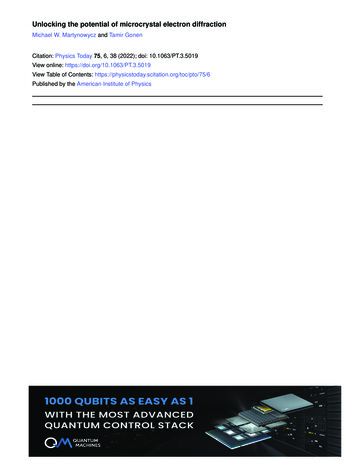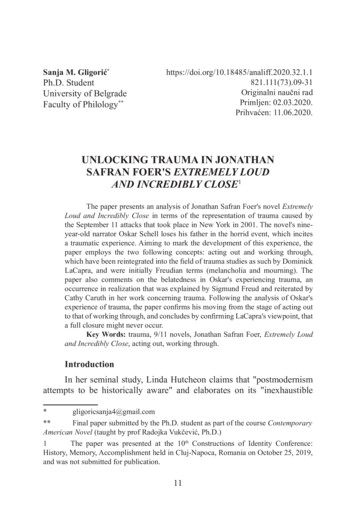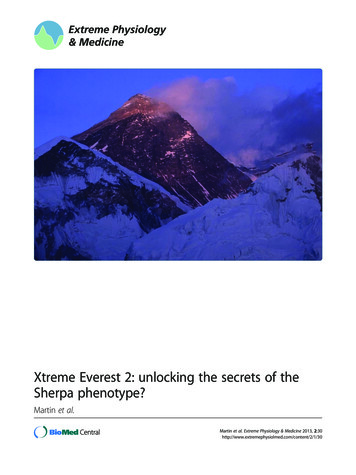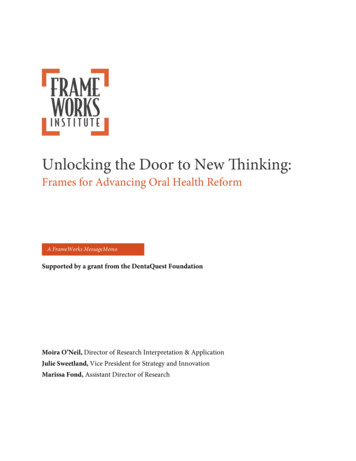
Transcription
Unlocking the potential of microcrystal electron diffractionMichael W. Martynowycz and Tamir GonenCitation: Physics Today 75, 6, 38 (2022); doi: 10.1063/PT.3.5019View online: https://doi.org/10.1063/PT.3.5019View Table of Contents: lished by the American Institute of Physics
Unlocking the potential ofMICROCRYSTALELECTRONDIFFRACTIONMichael W. Martynowycz and Tamir GonenStructural biologists are using cryogenicelectron microscopy to resolve atomic-scalestructures of proteins from nanocrystals.An electron-diffraction pattern of triclinic lysozyme. Calculationsbased on the position and intensity of the spots can produce acharge-density map like the one shown in figure 2.38 PHYSICS TODAY JUNE 2022
Mike Martynowycz is a research scientistand Tamir Gonen is a professor, both inthe department of biological chemistryat UCLA.Atoms stick together in different ways to make the molecules that compose everything we touch and see. Ourbodies are made of cells. Cells, in turn, are made oflipids, proteins, nucleic acids, metabolites, and water.Every one of those molecules is made from the samehandful of atoms. But although the components are the same, themolecules differ in how many atoms they have and how those atomsare arranged in space.Proteins are tiny biological machines. They do work at thenanoscale by moving molecules around, forming or breakingbonds, and catalyzing reactions. Structural biologists strive todetermine where all the atoms reside inside proteins. The mostcommon method uses high-energy x rays for the job. Purifiedproteins grow into three-dimensional crystals that act as diffraction gratings when exposed to coherent radiation. Rotatingthe crystal in the x-ray beam produces diffraction spots thatidentify the atoms’ locations inside the crystal.But growing proteins into crystals large enough for x-raydiffraction is challenging. Indeed, the most important proteinsfor human health rarely grow into crystals large enough forx-ray diffraction experiments to work on them, or they are toosensitive to the radiation and break down before the data canbe collected. Fortunately, a cryogenic electron microscopy(cryo-EM) method, known as microcrystal electron diffraction(MicroED),1 can determine protein structures from crystals assmall as one billionth the size of those used in traditional x-raycrystallography.The method uses the same cryogenic electron microscopesthat biologists rely on to image macromolecular complexes orto discern the 3D structure of entire cells—techniques knownas single-particle imaging and tomography, respectively. MicroED promises to open structural biology to new classes ofprotein nanocrystals and glean novel details from the tinyproteins.The structure–function relationshipUnderstanding what something does is powerful. It lets peopleknow, for instance, how to fix things that are broken. Scientistsrefer to that understanding as the structure–function relationship. Structural biologists care about how the machinery in ourbodies works and investigate how proteins operate by determining theiratomic structure. Beyond many othercritical functions, proteins can movesugar into cells, carry oxygen fromlungs to muscles, and produce electrical signals in our brains.The first step to determining a target protein’s structure has been togrow crystals of it. Fortunately, manyproteins can arrange into a repeating 3D pattern to make crystals. Such crystals are grown by isolating the pure protein andmixing it with various salts and additives that coerce the protein into small, ordered clumps that then grow outwardly intobeautiful, faceted shapes, as shown in figure 1a. Those crystalsare then interrogated by a beam of x rays.At large synchrotron light sources, strong magnetic fieldswhip electrons around circular tracks at relativistic speeds. Theaccelerating electrons emit a broad spectrum of light. Suchlight sources are enormous, with circumferences typically onthe scale of hundreds of meters. Stretching out from those ringsare end stations, at which the electromagnetic spectrum is filtered and an emerging x-ray beam is used for experiments.Protein crystals placed in the path of those beams diffract asmall fraction of the x rays into detectors that record theirpictures—tiny spots known as reflections, similar to the onesshown in the opening image. Calculations based on both thelocations and intensities of the reflections build up a map ofthe positions of every atom inside the protein.Although growing crystals is standard practice for x-raydiffraction, growing protein crystals large enough to be studied can take years or fail altogether. That bottleneck has ledmany structural biologists to search for other methods to determine a protein’s structure.Cryo-EM in retrospectThe 2017 Nobel Prize in Chemistry was awarded to JacquesDubochet, Joachim Frank, and Richard Henderson for theirdevelopment of cryo-EM of biomolecules in solution (seePhysics Today, December 2017, page 22). Traditional light microscopes magnify small objects by focusing light through glasslenses—an achievement limited by the wavelength of visibleJUNE 2022 PHYSICS TODAY 39
MICROCRYSTAL ELECTRON DIFFRACTIONabAMPLITUDEWavelengthX-rays 1.0 ÅElectrons 0.02 Å100 μmTIMEFIGURE 1. CRYSTALS and their diffraction. (a) Protein crystals of proteinase K, a serine protease, are seen through a light microscope.(b) The graph shows a comparison between the wavelengths of x rays (blue) and electrons (orange) typically used in diffraction experiments.With their much shorter wavelength, electrons can resolve much finer details of a biomaterial.light. Electrons, by contrast, have a wavelength far lower thanvisible light—smaller even than typical x rays (see figure 1b).And because they carry both charge and mass, electrons canbe accelerated to high velocity using electromagnetic lenses.The upshot: Electron microscopes produce images with detailsthat are far finer than can be seen with a light microscope.Even so, imaging biological material as small as an individualprotein is difficult. High-energy electrons must propagate in avacuum, which is incompatible with a liquid environment—thenatural home for most proteins. And those electrons can damage biological materials. To circumvent those problems, researchers developed methods to freeze the sample quicklyenough that the protein’s liquid surroundings cannot crystallize. They leave the proteins embedded in a thin layer of vitrified, amorphous ice. The frozen, hydrated state exists at aliquid-nitrogen temperature of about 320 F, an environmentthat is compatible with electron microscopy.Early cryo-EM studies that preceded the development ofrapid-freezing techniques typically focused on proteins thatgrew into large, 2D crystal arrays. Imaging them requiredembedding the protein crystals in another material, such assugar, that could withstand the vacuum and damaging electron beam inside the microscope. The first demonstration of 2Delectron crystallography showed that high-resolution diffraction patterns could be collected from thin protein crystalswithout the need to stain or fix them using a hydration stage.2That demonstration was followed by the first use of cryo-EMthat froze protein crystals and preserved them in a native hydrated state for subsequent electron diffraction studies.3In 1975 Richard Henderson and Nigel Unwin, both at theUK’s Medical Research Council Laboratory of Molecular Biology, presented the first 3D structural models by electron crystallography using glucose-embedded 2D crystals of the purplemembrane protein bacteriorhodopsin and bovine-liver catalaseat 7 Å and 9 Å resolution, respectively.4 They used both imagingand diffraction. Henderson and Unwin extracted phases fromFourier transforms of the images and combined those phaseswith amplitudes obtained from electron diffraction patterns.40 PHYSICS TODAY JUNE 2022Together the phases and amplitudes were then used to reconstruct a 3D density map.5 To pull off the achievement, theyconducted their experiments with a transmission electron microscope operating at room temperature.In 1984 Dubochet and collaborators developed a method torapidly freeze biological specimens by plunging them into liquid ethane.3 That procedure freezes the sample and water soquickly that the ice cannot form crystals; it becomes vitrified.The result is a frozen biological specimen that remains in itsnative hydrated state—an advance in sample-preparationtechnology that ultimately led to near-atomic-resolution models of bacteriorhodopsin from electron crystallography ofcryogenically preserved 2D crystals.6 Over the next couple ofdecades, researchers were able to achieve numerous milestonesby using cryo-EM and electron crystallography.In 2005, biologists resolved the first protein structure—thatof aquaporin-0 from “double-layer” 2D crystals—at near-atomicresolution by using cryo-EM.7 To discern the structure of thatchannel, one of us (Gonen) and collaborators relied on electroncrystallography that used only diffraction patterns recorded atvarious tilt angles. A major advantage of crystallography thatcan discern single or multiple layers is that membrane proteinscan be reconstituted in their native environment. The processallows researchers to study the proteins’ functionality and theirinteractions in the lipid bilayer.Diffraction from tiny 3D crystalsA similar approach revealed the structure of a 3D protein crystal.8 The Gonen group collected images of diffraction patternsfrom crystals of lysozyme at various angles and determinedthe structure by molecular replacement (see the article by QunShen, Quan Hao, and Sol Gruner, Physics Today, March 2006,page 46). The vitrified 3D crystals created small diffractionspots akin to x-ray diffraction experiments.Gonen and others subsequently modified the approach torecord data on a fast camera as the crystal was rotated in theelectron beam.9,10 Under those circumstances, the procedurewas analogous to the standard rotation method in macro-
FIGURE 2. SUBATOMIC-RESOLUTION STRUCTURE of tricliniclysozyme. The charge-density map was determined ab initio. Pinkspheres correspond to protein atoms (carbon, nitrogen, andoxygen, typically), and green spheres correspond to hydrogenatoms. Maps of this quality allow structural biologists to buildaccurate models of proteins that can aid drug discovery anddesign. (Adapted from reference 12.)What do electrons allow us to see?Researchers analyzing MicroED data use the same software asthose who analyze x-ray experiments. Both methods producea X-ray sca ering10b Electron sca eringHydrogenCarbonNitrogenOxygenO 8644AMPLITUDEmolecular x-ray crystallography, which made the data collection better and faster. Continuous rotation in MicroED experiments produced a higher-quality structure of the proteinlysozyme from a single microcrystal. And the data could easilybe processed using the same software as x-ray crystallography.MicroED data are rapidly collected by continuously rotatingvitrified crystals under low-dose conditions in a cryogenicallycooled electron microscope.1Following the initial MicroED studies on lysozyme andcatalase, which demonstrated the technique’s potential forstructural biology, researchers went on to resolve several otherstructures from 3D protein crystals, including various membrane proteins and ligand-bound complexes.11 This past yearthe two of us and two colleagues demonstrated true atomicresolution from MicroED data on the lysozyme,12 shown infigure 2. The demonstration sets the stage for future MicroEDstudies at subatomic resolution.Electron crystallography is also a useful technique for resolving the structure of small inorganic and organic molecules.While MicroED researchers adopted the approach and technologies of 2D electron crystallography of proteins, other researchers were using electron diffraction to characterize nonvitrified, radiation-hardy molecules. The two worlds ofstructural biology and materials science collided in 2018, whentwo groups independently applied electron diffraction tosmall-molecule pharmaceutical compounds.13,14In experiments by the two of us and several colleagues,13low-dose conditions were the norm. The conditions facilitatedrapid diffraction-data collection and structure determinationfrom beam-sensitive organic molecules. Preparation is relatively straightforward: Samples can be crushed or ground intoa dry powder and directly placed on a standard electron microscopy grid for MicroED.During data acquisition, the grid is exposed to the electronbeam, and individual crystals can be selected for MicroED analysis. If the samples being assayed contain mixtures of compounds,the process lets researchers identify the different compounds directly from the mixture at atomic resolution.13 That capabilityopens the field to many possibilities in the study of natural products and the characterization of pharmaceutical compounds.AMPLITUDE5Åa map, from which an atomic model is built. Although the samesoftware processes the data, the maps generated from themethods provide different information. Whereas x rays scatterfrom the electron cloud that surrounds an atom, electronsscatter from the atom’s electrostatic potential, which is generated by the interacting positive and negative charges.15Because each type of experiment uses different physicalphenomena, the information contained in their maps differs.X-ray scattering gives an electron-density map, which revealswhere the electrons are inside the crystal. And electron scattering produces a potential map.16 That potential depends on boththe element and its charge. The local environment can result inwildly different scattering amplitudes from a given atom, asshown in figure 3. Indeed, electron-diffraction experiments canreveal the state of electric charge for amino acids, ions, salts,and even solvent.2HydrogenCarbonNitrogenOxygenO 0 22 400.00.20.40.6sinθ/λ (Å 1)0.80.00.20.40.6sinθ/λ (Å 1)0.8cFIGURE 3. DIFFERENCES between (a) x-ray and (b) electronscattering from neutral and charged atoms. Whereas x rays scatterfrom an atom’s electron cloud independently, electrons arescattered by the charge environment. Vast differences in scatteringcan be seen for charged atoms. (c) This structure of an enzyme(gray) bound to drugs (blue) was determined by microcrystalelectron diffraction.11 With those diffraction patterns, researcherscan resolve biomolecular structures and screen new drugs anddiscern how they bind to different proteins.JUNE 2022 PHYSICS TODAY 41
MICROCRYSTAL ELECTRON DIFFRACTIONaUsing MicroED, they can determine the structure of thosedrugs quickly. Biologists can determine the atomic-resolutionstructure of the drug bound to the target protein with higherthroughput than if they were to attempt to crystallize the drugwith the protein beforehand.18 The electrostatic-potential mapof the bound drug directly reveals how the binding works andhow the charges interact. In that respect, MicroED aids thedrug-discovery process—by identifying the drug’s structure inorder for researchers to understand its interaction with theprotein.Future of phydMicroEDFIGURE 4. CRYOGENIC ELECTRON MICROSCOPY, in practice.(a) The internal components of a 300 kV microscope are shown,including (from top to bottom) an electron source, collimatedelectromagnetic lenses, a cryogenic sample chamber and stage(inset), and several camera systems. The same electron microscopecan be used for all modalities of cryogenic electron microscopy.Examples of (b) single-particle analysis, (c) cryotomography, and(d) cryogenic electron diffraction are shown here. In the first twocases, the microscope operates in imaging mode, and a structure iscalculated on the basis of the recorded pictures. In the last case, themicroscope takes the crystal’s diffraction patterns, from which thestructure can be determined. (Panel b adapted from K. M. Yip et al.,Nature 587, 157, 2020. Panel c adapted from M. Pöge et al., eLife 10,e72817, 2021.)The majority of medications approved by the US Food andDrug Administration are molecules with fewer than 70 atomsbound together in a complex 3D shape. Those small-moleculedrugs are typically composed of carbon, nitrogen, oxygen, andhydrogen. Hydrogens make up about 50% of the atoms in anygiven protein or drug. But it’s difficult to resolve the locationsof those hydrogens from diffraction patterns taken of proteinsand drugs with synchrotron x-ray radiation. That’s becausehydrogens are so much lighter than other elements and havea small electron cloud.Although those atoms can be seen in extremely high-qualitydata, most structural biology investigations cannot achieve thenecessary resolution to accurately find them. Instead, the hydrogen atoms are placed automatically in positions wheretheoretical considerations suggest they should be located.Scattering using electrons may allow biologists to identifyhydrogen atoms at more modest resolutions, because unlike xrays, electrons scatter strongly from hydrogen.By deciphering where those hydrogens are in a structure,12,17the biologists will be able to model how the drug will bind tothe protein receptor of interest. Better binding means that theymay design drugs with higher efficacy and fewer side effects.42 PHYSICS TODAY JUNE 2022The advent of MicroED for proteins and small molecules hascreated an incredible value for the transmission electron microscope as a structural-biology instrument. The same instrumentcan be used to take pictures of large proteins and complexesusing single-particle and cryogenic electron tomography andto resolve atomic structures from tiny crystals using MicroED,as shown in figure 4. Using just a transmission electron microscope, researchers could feasibly produce an entire drugdiscovery pipeline.The ability to probe charge and visualize potential insteadof electron-density maps is not unique to MicroED. It is aproperty of all electron-microscopy investigations. But reducing a sample to cryogenic temperatures has proven essentialfor probing the structure of biological materials. Indeed, MicroED opens a new world of structural-biology investigations:Locating hydrogen atoms, accurately modeling electric charge,and determining structures from nanocrystals all give themethod an edge in many investigations. The resulting data caninform deep-learning algorithms for solving the protein-foldingproblem and improve their predictive abilities. (See PhysicsToday, October 2021, page 14.) Together, such capabilities couldlead to rapid improvements in drug discovery. Using themethod to determine the structures of molecules that cannotbe resolved by any other means is just the beginning.Except where otherwise noted, the contents of this article are licensedunder a Creative Commons Attribution (CC BY) 4.0 license.REFERENCES1. B. L. Nannenga, T. Gonen, Nat. Methods 16, 369 (2019).2. V. R. Matricardi, R. C. Moretz, D. F. Parsons, Science 177, 268(1972).3. J. Dubochet et al., Trends Biochem. Sci. 10, 143 (1985).4. R. Henderson, P. N. T. Unwin, Nature 257, 28 (1975).5. D. J. De Rosier, A. Klug, Nature 217, 130 (1968).6. R. Henderson et al., J. Mol. Biol. 213, 899 (1990).7. T. Gonen et al., Nature 438, 633 (2005).8. D. Shi et al., eLife 2, e01345 (2013).9. I. Nederlof et al., Acta Crystallogr. D 69, 1223 (2013).10. B. L. Nannenga et al., Nat. Methods 11, 927 (2014).11. M. T. B. Clabbers, A. Shiriaeva, T. Gonen, Int. Union Crystallogr. J. 9, 169 (2022).12. M. W. Martynowycz et al., 1.13. C. G. Jones et al., ACS Cent. Sci. 4, 1587 (2018).14. T. Gruene et al., Angew. Chem. Int. Ed. 57, 16313 (2018).15. R. Henderson, Q. Rev. Biophys. 37, 3 (2004).16. K. Yonekura, S. Maki-Yonekura, J. Appl. Crystallogr. 49, 1517(2016).17. L. Palatinus et al., Science 355, 166 (2017).PT18. M. T. B. Clabbers et al., Commun. Biol. 3, 417 (2020).
page 46). The vitrified 3D crystals created small diffraction spots akin to x- ray diffraction experiments. Gonen and others subsequently modified the approach to record data on a fast camera as the crystal was rotated in the electron beam.9,10 Under those circumstances, the procedure was analogous to the standard rotation method in macro-










